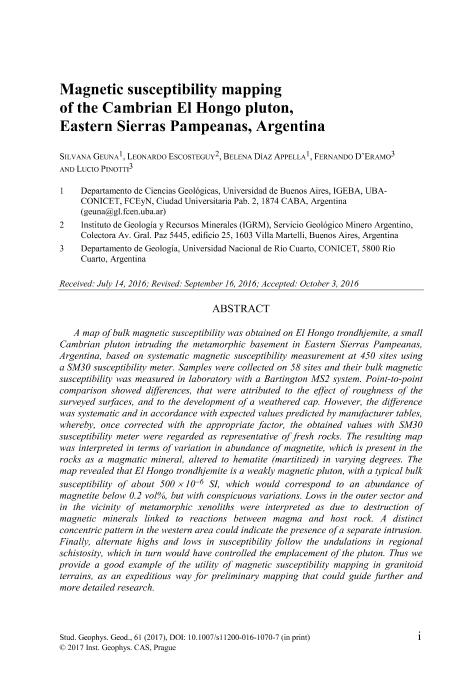Mostrar el registro sencillo del ítem
dc.contributor.author
Geuna, Silvana Evangelina

dc.contributor.author
Escosteguy, Leonardo Darío

dc.contributor.author
Díaz Appella, Belena Lucia

dc.contributor.author
D'eramo, Fernando Javier

dc.contributor.author
Pinotti, Lucio Pedro

dc.date.available
2018-11-28T18:02:17Z
dc.date.issued
2017-04
dc.identifier.citation
Geuna, Silvana Evangelina; Escosteguy, Leonardo Darío; Díaz Appella, Belena Lucia; D'eramo, Fernando Javier; Pinotti, Lucio Pedro; Magnetic susceptibility mapping of the Cambrian El Hongo pluton, Eastern Sierras Pampeanas, Argentina; Springer; Studia Geophysica Et Geodaetica; 61; 2; 4-2017; 219-232
dc.identifier.issn
0039-3169
dc.identifier.uri
http://hdl.handle.net/11336/65470
dc.description.abstract
A map of bulk magnetic susceptibility was obtained on El Hongo trondhjemite, a small Cambrian pluton intruding the metamorphic basement in Eastern Sierras Pampeanas, Argentina, based on systematic magnetic susceptibility measurement at 450 sites using a SM30 susceptibility meter. Samples were collected on 58 sites and their bulk magnetic susceptibility was measured in laboratory with a Bartington MS2 system. Point-to-point comparison showed differences, that were attributed to the effect of roughness of the surveyed surfaces, and to the development of a weathered cap. However, the difference was systematic and in accordance with expected values predicted by manufacturer tables, whereby, once corrected with the appropriate factor, the obtained values with SM30 susceptibility meter were regarded as representative of fresh rocks. The resulting map was interpreted in terms of variation in abundance of magnetite, which is present in the rocks as a magmatic mineral, altered to hematite (martitized) in varying degrees. The map revealed that El Hongo trondhjemite is a weakly magnetic pluton, with a typical bulk susceptibility of about 500 × 10−6 SI, which would correspond to an abundance of magnetite below 0.2 vol%, but with conspicuous variations. Lows in the outer sector and in the vicinity of metamorphic xenoliths were interpreted as due to destruction of magnetic minerals linked to reactions between magma and host rock. A distinct concentric pattern in the western area could indicate the presence of a separate intrusion. Finally, alternate highs and lows in susceptibility follow the undulations in regional schistosity, which in turn would have controlled the emplacement of the pluton. Thus we provide a good example of the utility of magnetic susceptibility mapping in granitoid terrains, as an expeditious way for preliminary mapping that could guide further and more detailed research.
dc.format
application/pdf
dc.language.iso
eng
dc.publisher
Springer

dc.rights
info:eu-repo/semantics/openAccess
dc.rights.uri
https://creativecommons.org/licenses/by-nc-sa/2.5/ar/
dc.subject
Handheld Susceptibility Meter
dc.subject
Ilmenohematite
dc.subject
Magnetic Susceptibility
dc.subject
Magnetite
dc.subject
Martitization
dc.subject.classification
Meteorología y Ciencias Atmosféricas

dc.subject.classification
Ciencias de la Tierra y relacionadas con el Medio Ambiente

dc.subject.classification
CIENCIAS NATURALES Y EXACTAS

dc.title
Magnetic susceptibility mapping of the Cambrian El Hongo pluton, Eastern Sierras Pampeanas, Argentina
dc.type
info:eu-repo/semantics/article
dc.type
info:ar-repo/semantics/artículo
dc.type
info:eu-repo/semantics/publishedVersion
dc.date.updated
2018-10-23T21:34:14Z
dc.journal.volume
61
dc.journal.number
2
dc.journal.pagination
219-232
dc.journal.pais
Alemania

dc.journal.ciudad
Berlin
dc.description.fil
Fil: Geuna, Silvana Evangelina. Consejo Nacional de Investigaciones Científicas y Técnicas. Oficina de Coordinación Administrativa Ciudad Universitaria. Instituto de Geociencias Básicas, Aplicadas y Ambientales de Buenos Aires. Universidad de Buenos Aires. Facultad de Ciencias Exactas y Naturales. Instituto de Geociencias Básicas, Aplicadas y Ambientales de Buenos Aires; Argentina
dc.description.fil
Fil: Escosteguy, Leonardo Darío. Secretaria de Industria y Mineria. Servicio Geológico Minero Argentino. Instituto de Geología y Recursos Minerales; Argentina
dc.description.fil
Fil: Díaz Appella, Belena Lucia. Consejo Nacional de Investigaciones Científicas y Técnicas. Oficina de Coordinación Administrativa Ciudad Universitaria. Instituto de Geociencias Básicas, Aplicadas y Ambientales de Buenos Aires. Universidad de Buenos Aires. Facultad de Ciencias Exactas y Naturales. Instituto de Geociencias Básicas, Aplicadas y Ambientales de Buenos Aires; Argentina
dc.description.fil
Fil: D'eramo, Fernando Javier. Consejo Nacional de Investigaciones Científicas y Técnicas; Argentina. Universidad Nacional de Río Cuarto. Facultad de Ciencias Exactas, Fisicoquímicas y Naturales. Departamento de Geología; Argentina
dc.description.fil
Fil: Pinotti, Lucio Pedro. Consejo Nacional de Investigaciones Científicas y Técnicas; Argentina. Universidad Nacional de Río Cuarto. Facultad de Ciencias Exactas, Fisicoquímicas y Naturales. Departamento de Geología; Argentina
dc.journal.title
Studia Geophysica Et Geodaetica

dc.relation.alternativeid
info:eu-repo/semantics/altIdentifier/url/https://link.springer.com/article/10.1007/s11200-016-1070-7
dc.relation.alternativeid
info:eu-repo/semantics/altIdentifier/doi/https://dx.doi.org/10.1007/s11200-016-1070-7
Archivos asociados
